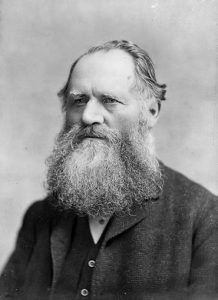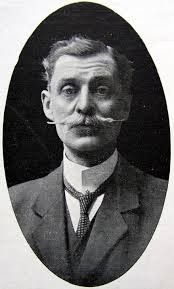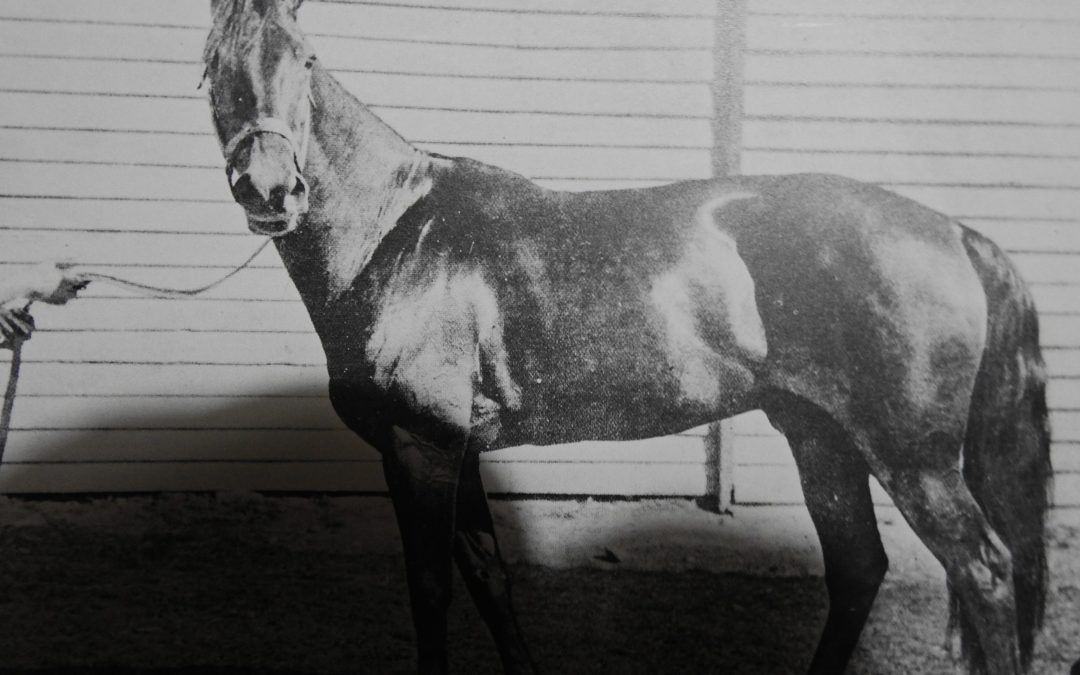STARS BEFORE THE DAWN (2)
Famous performers of the pre Addington era
CALISTA
A disagreement between New Zealand’s leading farmer and New Zealand’s leading harness club cost the country a trotting superstar in the pre-Addington pioneer racing days.
She was trained and ridden by a well known comedian when sold to Australia but the laugh was on us.
Calista,very green, was beaten by a masterly prepared Princess,an Ashburton quinella in what is regarded as the first major trotting meeting held in New Zealand, at Forbury in 1889.
It was promoted by the then Dunedin Jockey Club. But she soon emerged as a star in her own right for John C N Grigg, by then manager of the famous Longbeach estate, the so called “model farm of the Southern Hemisphere” near Ashburton, co- founded by his father, also John.

John Grigg the elder imported many mares who were foundation harness racing stock from the 1860’s
So many track and road trotters were bred at Longbeach by the Griggs in early days from imported stock it was like Woodlands Stud today-only bigger.
Identity being less scientific in those days not all of them may have been quite what they seemed. The number of mid Canterbury “unnamed mares” title for founders of top families added to that. Several still famous families (Polly eg) traced to “the Longbeach area”.Polly ancestress of champions like Gold Bar and multiple modern stars was bought by the Hood family from a Rakaia road contractor.The most successful at the time was Calista’s granddam, Gentle Annie,officially by the thoroughbred stallion,Sportsman,from a “half-bred” mare.
Gentle Annie first came over to the Otago goldfields where she was bought by Samuel Garforth who moved on to the West Coast diggings and proved her the champion there too,virtually unbeatable in any race or match,track or road,in that era where she was wanted. It was topped by an easy win in a four mile (6400m) road match from the Styx to the city for a big stake watched by a large crowd conceding 20k in rider weights.
Garforth,was a keen and highly successful stock breeder and took over what was the first commercial stud in Canterbury known as Spreydon Lodge. He developed widely sought after cattle and sheep bred on the property .
Garforth is the official breeder of Calista from Gentle Annie’s daughter, Southern Queen-by pioneer trotting import,Berlin-but the real honour seems to belong to his associates,the Griggs,senior and junior,who had control of her for some years.The Griggs bred, bought and sold enormous numbers of horses, cattle and sheep.
Gentle Annie,something of a legend in her time and who favoured the pacing gait,was most famous for breeding top colts. Her sons.Spot and Dexter in particular produced many stars of track and road in that era at Longbeach.
Dexter was the sire of Princess the first champion in our history as a result of her clean sweep at Dunedin.She was also a pacer,rare then. Southern Queen was Gentle Annie’s only foal by a standardbred sire,there being none around for most of her career.She died at Spreydon Lodge in 1881 aged 25 having had eight foals.
John C Grigg had been an outstanding sportsman at Christ’s College setting a then stunning 100 yards record of close to 10 seconds, and said to be later the champion sprinter of Cambridge University -so perhaps our first international track star. He appears to have deserted trotting as an owner after the Calista incident but he and his descendants were industry leaders in thoroughbred racing for close to a century. He was also a noted amateur astronomer building special equipment himself to track the night skies.
There were rumours for years Gentle Annie, a term then in common use for horses, rivers and even towns, might have had actually originated in America.
It was not uncommon in those days for horses,almost certainly stolen,being exported from the US to obscure ports in Australia,given a new “history” and put through a sale ring to make it official. Sending them on to New Zealand was another “clean sheet”.The fact she and her descendants favoured the pacing gait with such ability added to the intrigue.
Australian sources stuck to the official pedigree and there it ended.The fact remained when she died media reported that “unfortunately her breeding could never be properly traced”.
John Grigg II had been vice president of the Canterbury Trotting Club (Addington Showgrounds) but had resigned in 1890 as a protest over the handicaps Calista was being made to concede. At the 1891 Summer meeting at the Showgrounds, Calista, having won an unheard of four races in succession,and having annihilated her rivals in the Spring Cup on the track from a long mark, was handicapped to give the limit markers a huge 115 seconds over a four mile (6400m) Summer Cup-roughly 1600m!
So when local racing trainer,Dan O’Brien,made an offer for the mare just before the race, a frustrated Grigg accepted.
Calista trotted roughly for 3200m and was then pulled up.A large crowd had gathered to see the wonder mare of the time and were not amused. Grigg was still the official owner and had told rider Charles Douglas to go for half the trip and then pull her up if she could not win. O’Brien who had only bought the mare after Douglas weighed out,was heard to tell him to win if he could but “not to knock the mare about”
She would have had to run just over 10 minutes to win, an absolutely sensational mile rate in the era.The 5.22 she ran for the Spring Cup had been a national record and stood for years.O’Brien wrote to the media in support of Grigg, a genuine horse lover who could only see heartbreakers in the future of Calista on the local racing scene.
Calista raced for some 10 years in Australia. In her prime she beat all the best it could offer, including their male star Osterley in one of the famous Time Tests .These were mile heats, one each day over three days of the Melbourne Show. The best average time of three was the winner.This was the showcase trotting event of the season and Calista won it multiple times.Like Yum Yum she also raced against her own offspring Alista-a top performer -and occasionally beat her,from handicaps up to 250m.
One of her bigger wins,at the Melbourne Show, came just nine weeks after she had weaned a foal. Alista as the first racing foal by Osterley from the champion mare was labelled as “a match made in heaven”.
Calista won an 800m race in 1899- off a 120m handicap!.
What added to her headline appeal was the fact that she was trained and driven/ridden by a famous Melbourne variety performer, Will Whitburn,the son of a trainer and one of the elite horsemen of his time when not on the stage-a most unusual combination. He followed American trends closely and imported or copied pioneer equipment including the latest sulky (the Melbourne track was too rough for it) and an American style training track with cambered bends,better than the local race circuits.He was most

Actor Will Whitburn in middle age.He triumphed in two very different professions
famous for training Osterley’s champion son, Emulator, a mile record holder in Australia for many years.
In 1897 Calista went inside the Australian mile record for a mare,first winning a race, then an hour later trialling in 2.19-five seconds inside the previous best. At times she was starting over 500m behind.While the premier mare she was now no match for the freakish Fritz who could trot 2.14.The fact she was by Berlin and Fritz from a Berlin mare underlined the pioneer’s influence.
Calista returned to Christchurch to campaign in 1899 but without success. She was then 15.In 1904 she was sold to Sydney to leading sportsman Francis Foy.
A persistent story in the history books claims Calista then went to America.She was rising 20 when Foy bought her and with a foal at foot. Hard to see the point . A passenger ship named Calista then regularly sailed to America . That may have caused some confusion as in “Calista has sailed to America”
The Southern Queen breed had a resurrection in the late 1930’s when Betty Boop (Auckland Cup) and Prince Author were headliners. Then came Karamu who left a good mid-range pacer for Pat O’Reilly in Water Ranger most famous for his only named foal,sired as a three year old,Aqua Lady, being an Inter Dominion heat winner for the O’Reilly stable The next generation produced a host of winners from another unfashionably bred mare, Noble Ann for the Sprott family of Rakaia and trainer Jackie Behrns. Most had “Kyle” in their name or the classy Space Cadet and False Step’s first winner from a handful of foals,Stepson,also trained by Cecil Devine.
This family had strong associations over decades with local with mid- Canterbury based sires and families.Calista would have added to that -but for a harsh handicapper,and an owner who would not see her ability sacrificed on the altar of impossible tasks.
MAIN PIC-The great Australian trotter Fritz,considered equal to America’s best in his prime,and the only one of the era who could beat Calista.
